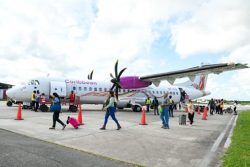LIMA, (Reuters) – Up to 33 people died and 100 were wounded as Amazon tribes clashed with Peruvian police yesterday in escalating protests against the government’s drive to lure foreign energy and mining companies into the rain forest.
In the worst unrest of President Alan Garcia’s current government, tribal leaders said at least 22 protesters were killed. The government reported the deaths of 11 police officers, some from stab wounds, and three demonstrators.
Angry protesters responded by taking a group of police hostage near an oil pumping station of state-owned Petroperu. They threatened to set it ablaze unless police called off efforts to break up demonstrations in the Amazon basin.
“We have taken 38 police hostage,” Carlos Huaman, a protester, said on RPP radio. “There are 2,000 of us and we are ready to burn the station.”
The conflict, which has prompted calls for Garcia’s prime minister and interior minister to quit, has underscored deep divisions in Peru between wealthy elites in Lima and poor indigenous groups in the countryside.
Critics say the government has not done enough to lower the poverty rate from 36 percent and that economic boom times enjoyed before the current downturn failed to reach the poor.
“I hold the government of President Alan Garcia responsible for ordering this genocide,” indigenous leader Alberto Pizango told reporters in Lima as the government issued a warrant for his arrest for encouraging the protests.
Members of Garcia’s cabinet accused protesters of being inflexible, refusing to negotiate and said they would impose curfews. “The government had to act to impose order and discipline,” said Prime Minister Yehude Simon.
Simon, a former left-wing activist who was hired a year ago by Garcia to help avert social protests, has failed for weeks to negotiate a peaceful end to the blockades.
In the violence yesterday, indigenous leaders said police shot at hundreds of protesters from helicopters to end a roadblock on a remote jungle highway 870 miles (1,400 km) from Lima, the capital.
Police said protesters fired first, but tribesmen denied having guns and said they only carried traditional spears.
Thousands of Amazon natives, demanding more control over natural resources, have intermittently blocked roads and waterways since April to try to force the government to revoke a series of investment laws passed last year and to revise concessions granted to foreign energy companies.
The laws encourage oil, mining, and agricultural companies to invest billions of dollars in the mostly pristine region.
Opposition leaders from the left and right said Garcia should fire Prime Minister Simon and Interior Minister Mercedes Cabanillas for allowing the standoff to turn violent.
“This is very damaging for Peru,” former President Alejandro Toledo said in an interview with television network Canal N. “Garcia needs to show leadership.”
The protests have shut the main pipeline that carries oil from the Amazon to the Pacific Ocean for weeks and highlighted the risks of investing in Peru.
Argentina’s Pluspetrol, which had already curtailed most work at its lot 1AB in northern Peru, said yesterday it halted production. It normally pumps about a fifth of Peru’s total oil output. In April, lot 1AB produced about 16,770 barrels a day.
Garcia, whose approval rating is just 30 percent, blamed protesters for provoking violence and said it was time to lift the blockades of roads, rivers and energy installations.
“It appears that this is being done to generate disorder for electoral reasons,” Garcia said.
Garcia’s allies have at times linked the protests to populist opposition leader Ollanta Humala, who spooked investors when he nearly won the 2006 presidential race and is expected to run again in 2011.
Humala, who enjoys support among the rural poor, said Garcia’s APRA party made a serious error on Thursday, when it blocked a motion in Congress to open debate on a law that tribal leaders want to revise or overturn.
Some of the controversial laws encouraging foreign investment in the Amazon were passed last year as Garcia moved to bring Peru’s regulatory framework into compliance with a free-trade agreement with the United States.
“The government has decided to solve this social, economic and political problem not in Congress, where it should be solved, but on the battlefield,” Humala said.





